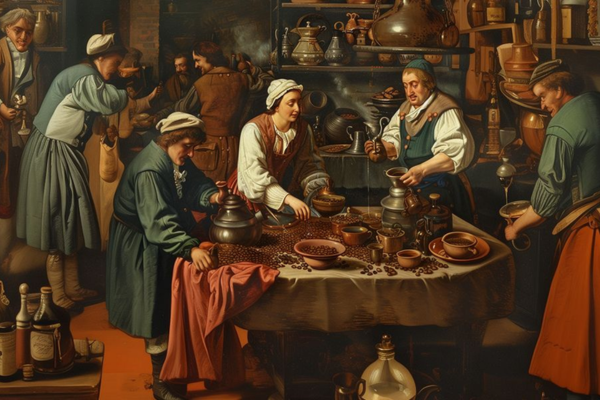
Coffee is one of the most beloved beverages in the world, fueling our mornings, social interactions, and creative pursuits. Yet, coffee culture has evolved dramatically since its humble beginnings. From the ancient coffee ceremonies of Ethiopia to the modern coffeehouse chains found in every major city, the way we consume and appreciate coffee reflects broader societal changes. The evolution of coffee culture reveals stories of trade, revolution, globalization, and creativity.
In this article, we’ll journey through the fascinating history of coffee culture, exploring how caffeine has traveled across continents and shaped the social fabric of various societies.
1. The Origins: From Ethiopian Hills to Arabian Courts
The story of coffee begins in Ethiopia in the 9th century. Legend has it that a goat herder named Kaldi discovered coffee when he noticed his goats dancing energetically after consuming red cherries from a particular shrub. This discovery led to the first recorded uses of coffee, primarily for its stimulating effects.
By the 15th century, coffee had made its way to Yemen, where Sufi mystics used it to stay awake during long prayers and meditations. The drink, known as “qahwa,” became an essential part of spiritual and social life. Yemeni traders cultivated coffee plants and exported beans through the port city of Mocha, a name that still resonates in modern coffee culture.
Arabian coffeehouses, or “qahveh khaneh,” began to flourish in cities like Mecca, Medina, and Cairo. These early coffeehouses were hubs for intellectual discussion, storytelling, and political debate, establishing coffee as a drink that not only stimulated the body but also the mind.
2. Coffee Conquers Europe: The Rise of Coffeehouses
Coffee arrived in Europe in the early 17th century, thanks to trade routes connecting the Middle East and the Mediterranean. The first European coffeehouse opened in Venice in 1645, and the drink quickly gained popularity among merchants, scholars, and artists.
In England, coffeehouses became known as “penny universities” because, for the price of a penny, patrons could buy a cup of coffee and engage in lively discussions with thinkers and professionals. These establishments were breeding grounds for innovation and commerce. For instance, Lloyd’s of London, the famous insurance market, started as a coffeehouse where merchants exchanged information.
In France, coffee culture took off when King Louis XIV’s court embraced the drink. French intellectuals like Voltaire and Rousseau frequented coffeehouses to discuss Enlightenment ideas. By the late 17th century, Vienna had developed its own coffee culture, where Viennese cafés became known for their sophistication, elegance, and the introduction of coffee served with milk and sugar.
This period saw coffee become a symbol of modernity, intellectual freedom, and social mobility. Coffeehouses were more than places to drink; they were engines of societal transformation.
3. The New World: Fueling Revolution and Industry
In the 18th century, coffee made its way to the Americas, where it became a symbol of independence and enterprise. During the American Revolution, coffee replaced tea as the patriotic beverage of choice after the Boston Tea Party in 1773. Drinking coffee became a statement of defiance against British rule.
The spread of coffee cultivation in the Americas was driven by European colonists who saw its potential as a cash crop. Brazil emerged as a coffee superpower after coffee plants were smuggled from French Guiana in 1727 by Francisco de Melo Palheta. The country’s favorable climate and vast plantations turned Brazil into the world’s largest coffee producer.
In the 19th century, coffee became synonymous with the Industrial Revolution. Workers relied on coffee to stay awake during long shifts, and coffeehouses served as meeting places for laborers, intellectuals, and activists. In the United States, the proliferation of diners and coffee shops in the early 20th century cemented coffee as an essential part of American culture.
4. The Espresso Revolution: Italy and the Birth of Modern Coffee Culture
The invention of the espresso machine in Italy during the early 20th century marked a turning point in coffee culture. In 1901, engineer Luigi Bezzera patented the first espresso machine, which produced a quick, concentrated shot of coffee. This innovation gave rise to espresso bars across Italy, where coffee could be enjoyed quickly, standing at the counter.
Espresso culture in Italy is defined by its rituals and rules. Cappuccinos are reserved for the morning, while espresso is consumed throughout the day. The act of drinking espresso is swift but intentional, a moment of quality and craftsmanship.
Italian-style coffee soon spread beyond Italy, influencing the development of global coffee culture. Espresso drinks like lattes, macchiatos, and Americanos became popular in countries around the world, setting the stage for the modern café experience.
5. The Third Wave: Artisanal Coffee and the Pursuit of Quality
In the late 20th and early 21st centuries, coffee culture underwent another transformation with the rise of the Third Wave Coffee Movement. This movement emphasizes coffee as an artisanal product, focusing on quality, sustainability, and transparency.
Third Wave coffee shops prioritize:
Single-origin beans, highlighting the unique flavors of specific regions.
• Direct trade and fair compensation for coffee farmers.
• Manual brewing methods like pour-over, siphon, and cold brew.
Pioneering companies like Stumptown Coffee Roasters, Blue Bottle Coffee, and Intelligentsia have championed this approach, educating consumers about the complexities of coffee flavor profiles and the importance of ethical sourcing.
The Third Wave movement reflects a broader cultural shift toward authenticity, craftsmanship, and environmental responsibility. Coffee drinkers are no longer satisfied with generic, mass-produced brews; they seek out quality, story, and connection in every cup.
6. Coffee in the Digital Age: Globalization and Technology
Today, coffee culture is more globalized and accessible than ever before. The rise of international chains like Starbucks has brought the café experience to nearly every corner of the world. With the advent of technology, coffee enthusiasts can order specialty beans online, follow their favorite roasters on social media, and learn brewing techniques through video tutorials.
Platforms like Instagram, TikTok, and YouTube have turned coffee preparation into an art form, popularizing trends like latte art, Dalgona coffee, and home brewing tutorials. The “Fourth Wave” of coffee, driven by innovation and technology, continues to push the boundaries of what coffee culture can be.
Despite these modern trends, the core of coffee culture remains the same: it is about connection, community, and the simple joy of a good cup of coffee.
Conclusion
The evolution of coffee culture is a testament to the adaptability and enduring appeal of this remarkable beverage. From ancient Ethiopian hillsides to bustling urban coffee shops, coffee has woven itself into the fabric of human society. Each wave of coffee culture reflects changing social, economic, and technological dynamics, but the essence of coffee—bringing people together and sparking conversation—remains unchanged.
As you enjoy your next cup, remember that you are participating in a tradition that spans centuries and continents. Coffee is more than just a drink; it is a cultural chronicle, a shared story, and a daily ritual that continues to evolve.
Enjoy your brew! ☕
